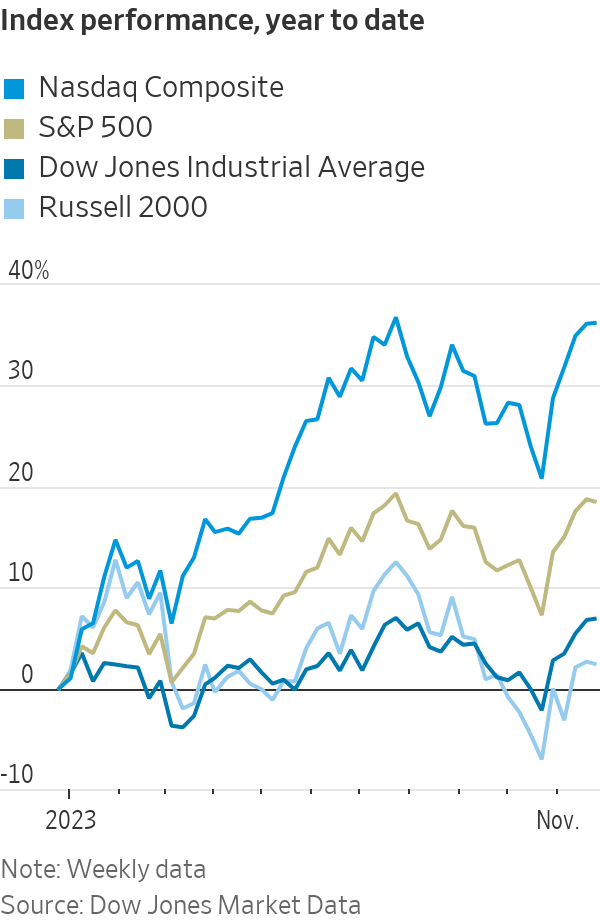What the Stock Market Taught Us This Year: Don’t Fall for These Investing Traps
2023 has been a year in which investors have been more influenced by perception than reality. And that means opportunities in 2024.
The uncertainty around near-term interest rates has dominated the story of the stock market in 2023. Perhaps not since the 1970s—when runaway inflation and sky-high interest rates were the crisis du jour—has monetary policy affected investment outcomes in such a pronounced way.
Yet look more closely, and it would seem that Wall Street has been more influenced by perception than reality: Company and individual balance sheets remain mostly healthy, businesses are battle tested and unemployment remains low. Similarly, the malaise surrounding the economic environment belies what we are seeing. Cruise ships are sold out, restaurants are packed, holiday shopping was off to a strong start and 82% of S&P 500 companies reported a positive earnings surprise in the third quarter.
Still, a nervous atmosphere has undercut stock performance. Scores of share prices have been lacklustre as company fundamentals have been eclipsed by macroeconomic conjecture. We have lost the trees in the forest.
But as someone once declared, “It is a market of stocks, not a stock market.” This is a wise reminder that no matter the conditions, there are investment opportunities to be had. In fact, the more economic obfuscation, the more sectors are hammered, the more stocks are orphaned, the better the odds of long-term investment success.
After a year of hand-wringing through monetary policy guesswork and market fluctuations, many wonder how best to maneuvre in the new year. Here’s our advice: Avoiding some of the biggest market traps can be a winning strategy.
Don’t Fed-watch
“Don’t fight the Fed” is a well-known market mantra. The idea is to buy stocks when the Fed is lowering interest rates and sell when the Fed is raising them.
This psychology has dominated the stock market all year, creating a futile guessing game. Are they still raising rates? For how much longer? Will rates fall soon? Will it be a hard landing or a soft landing? But this Fed obsession, reacting to every pronouncement, simply sucks up time. It has all been noise. Despite the fear and uncertainty, dire predictions didn’t come true.
What that means is that sectors that sold off because of heightened fears—including banks, some industrial names and anything real estate related—could be well-positioned for investors willing to take a longer-term view.
After surviving a midyear crisis, for instance, the banking sector is already beginning to show signs of recovery as market anxiety subsides. Similarly, oversold housing-related stocks should rebound once people adjust to the new rate environment, and the U.S. housing shortage, exacerbated by the pandemic, drives new construction.
It doesn’t mean every sector that got hit by investor angst is ripe for buying. Commercial real estate is an obvious example. But it does mean that if you invested by watching the Fed like a tennis match, and then reacting to every volley, you will get it wrong.
Don’t buy the hype
The selloff in many areas has inflicted pain that has been concealed by the cap-weighted dominance of a few celebrity stocks in the S&P 500 index. A handful of tech and tech-related stocks, weight-loss drugs and artificial-intelligence providers offer the sum total of stock-market outperformance this year. Beyond these headliners, there is less and less attention on individual names.
Those tech behemoths, dubbed the “Magnificent Seven,” account for more than 30% of the index and 87% of its return through October. Let us say that again: Just seven stocks represent one-third of the S&P 500 index. Some now consider Google parent Alphabet, Amazon.com, Apple, Facebook parent Meta Platforms, Microsoft, Nvidia and Tesla to be defensive businesses that can grow through any economic cycle.
We’ve seen this before, and the lesson is always the same: Winner-takes-all can dominate over shorter time frames but is rarely a winning bet in the long run. At some point, this narrow market supremacy will end, to the benefit of many overlooked issues.
In other words, these hyped celebrity stocks have more downside than upside from here. There are more-compelling opportunities to be had.

For example, the small-fry stocks found in the Russell 2000 index are among the most neglected shares waiting to get their due. The index has been languishing in a bear market since 2021—partially driven by their perceived economic sensitivity and partially driven by Wall Street indifference.
The result is that the total market cap of the Magnificent Seven is now three times the size of every single stock in the Russell 2000 index combined—making just seven stocks the equivalent of 6,000 small-cap names. On average, 47 analysts follow the typical Magnificent Seven stock versus just five for a small-cap name. Nine percent of smaller companies have no followers at all.
Here’s the silver lining: Less coverage means more market inefficiency means more opportunities. Stock prices trade on fundamentals. And when those solid fundamentals shine through, share prices rise. Additionally, when tepid U.S. growth inevitably picks up, small-caps are poised to strongly outperform as they have done every other time in the past.
The upshot is that you can go ahead and buy the hype if you want to, blinded by the celebrity names. But that’s not where the upside opportunities are likely to be.
Don’t anchor to the here and now
This time is different. Except it hardly ever is.
That’s a lesson investors rarely learn. Case in point: the extremely low interest rates that have persisted for much of the past two decades. Over the past 50 years, U.S. interest rates have averaged 5.98%. Today’s 5.5% rate seems high compared with the 0.25% paid during the recession of 2008, but no comparison to 1980 when rates topped out at 20%.
Similarly, at the start of the new millennium, a 30-year fixed-rate mortgage was 8.08%—basically in line with 2023 levels, but significantly higher than the bargain 2.96% rate that could be had just two years ago.
Higher interest rates now feel like a shock to our systems because we got anchored to some extreme lows. When considered in the full context of a longer history, though, they are in line.
Now people are anchored to the S&P 500 beating everything else. But just as we have seen with interest rates in 2023, the trend will revert to the mean, even if it takes a while.
Don’t fear volatility
Although it may feel uncomfortable, it is often easier to invest at the extremes—when valuations are crushed, buy signals are blaring and the bad news is priced in. Such conditions have the greatest profit potential, but the inherent volatility makes investors nervous.
This angst is playing out in the price action surrounding earnings announcements. FactSet reports that stocks are getting hit harder for negative earnings surprises. In turn, this drives up their volatility. In the third quarter, an earnings miss cost the typical company 5.2% in market value—more than twice the 2.3% average over the past five years.
Instead of running for the exits, we view volatility as our friend and actively seek to take advantage of the price movements. Everyone says they want to buy low, but when the opportunity arises, many wait for the dust to settle and miss the moneymaking moment.
Don’t bet against America
The market has turned more optimistic as the year winds down and we see plenty of value-beneath-the-surface stocks.
But even if investors have found some trees, they still have some concerns about the forest. Two terrible wars, congressional dysfunction, a border emergency and mounting unrest lurk over our economy as well as those around the globe.
In these unnerving moments, we are comforted by the faith in the resiliency of our capitalist democracy from capitalism’s own Yoda, Warren Buffett. He wrote in the 2012 Berkshire Hathaway shareholder letter, “Of course, the immediate future is unknown; America has faced the unknown since 1776…. Periodic setbacks will occur, yes, but investors and managers are in a game that is heavily stacked in their favour.”
Indeed, our markets have overcome a Great Depression, multiple recessions, global and regional conflicts, a modern-day pandemic and all other kinds of unforeseeable blows. Through it all, America has endured, and we have every reason to believe she will continue to do so.
Mellody Hobson is co-CEO and president, and John W. Rogers Jr. is founder, co-CEO and chief investment officer, of Ariel Investments.
 Copyright 2020, Dow Jones & Company, Inc. All Rights Reserved Worldwide. LEARN MORE
Copyright 2020, Dow Jones & Company, Inc. All Rights Reserved Worldwide. LEARN MORE
This stylish family home combines a classic palette and finishes with a flexible floorplan
Just 55 minutes from Sydney, make this your creative getaway located in the majestic Hawkesbury region.
More millionaires call New York City home than anywhere else in the world, according to a report from international wealth migration specialists Henley & Partners.
The Big Apple, which has seen its high-net-worth population jump by 48% over the past decade, is home to 349,500 millionaires, 744 centi-millionaires—those with liquid investable wealth of over US$100 million—and 60 billionaires, according to the firm, which collaborated with data intelligence firm New World Wealth for the analysis.
The city also ranked as the top spot for millionaires last year.
California’s Bay Area, encompassing San Francisco and the tech-mecca of Silicon Valley, ranked second. Wealth in the Bay Area has grown at one of the fastest rates in the world, increasing its number of wealthy citizens by a sizeable 82% over the past decade. It’s now home to 305,700 millionaires, 675 centi-millionaires, and 68 billionaires.
New York and the Bay Area were among 11 areas in the U.S. on the top 50 ranking, making the country the world’s foremost hub of moneyed residents.

Across the pond, London, which ranked as the wealthiest city in the world for many years, tumbled down the ranking, and now sits in fifth place with just 227,000 millionaires, 370 centi-millionaires, and 35 billionaires, a decline of 10% over the past decade, said the report, which was released earlier this week.
Cities with the fastest growing wealth, meanwhile, can be found in China.
Shenzhen’s wealthy population is snowballing most, with their numbers surging by 140% in the last 10 years, the report said.
“Hangzhou has also experienced a massive 125% increase in its [high-net-worth] residents, and Guangzhou’s millionaires have grown by 110% over the past decade,” said Andrew Amoils, head of research at New World Wealth, in the report.
Looking ahead, when it comes to wealth growth potential over the next decade, “cities to watch include Bengaluru, India; Scottsdale, Arizona; and Ho Chi Minh City in Vietnam,” he added. “All three have enjoyed exceptional growth rates of over 100% in their resident millionaire populations over the past 10 years.”
Underpinning the growth of the world’s wealthiest cities has been the robust performance of financial markets of late, from the S&P 500 to Bitcoin, according to Juerg Steffen, CEO of Henley & Partners.
Plus, “rapid advancements in artificial intelligence, robotics, and blockchain technology have provided new opportunities for wealth creation and accumulation,” Steffen said. “Yet, even as new opportunities emerge, old risks persist. The war in Ukraine, which has seen Moscow’s millionaire population plummet by 24% to 30,300, is a stark reminder of the fragility of wealth in an uncertain and unstable world.”
Just 55 minutes from Sydney, make this your creative getaway located in the majestic Hawkesbury region.
This stylish family home combines a classic palette and finishes with a flexible floorplan





















